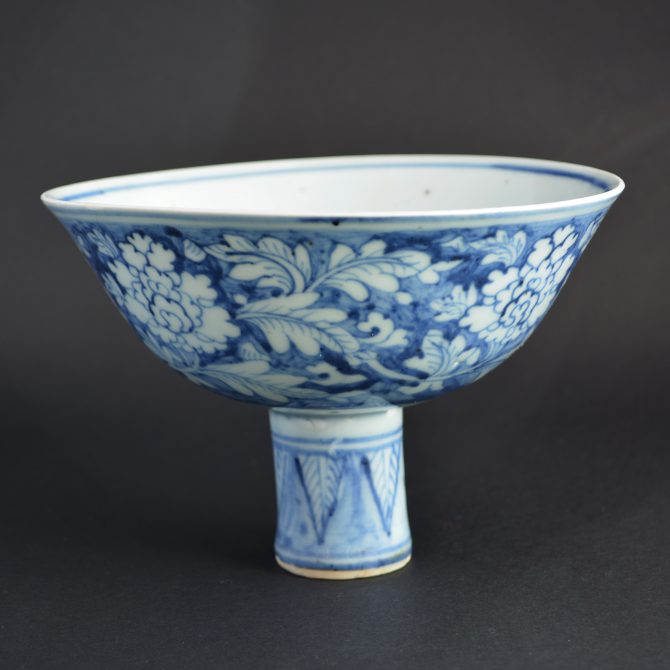
CHENGHUA or HONGZHI c.1480 – 1500 Ming Porcelain
A Rare Large Ming Porcelain Stem Bowl, 15th Century. Chenghua 1465-1487 or Hongzhi 1488-1505 Period, c.1480-1500. The Large Thinly Potted Blue and White Porcelain Stem Bowl is Painted with Open Peony Flowers on Long Trailing Stems with Leaves at Different Angles Set Against a Washed Blue Ground, The Stem with Stiff Leaves (Plantain leaves). The Interior With Chrysanthemum Flower-head with Smaller Flowers and Half Flowers.
SOLD
- Condition
- Damaged : there is a crack to the rim c.53 mm and another crack c.33 mm long, this has a filled chip that is c.18 x 4 mm to the interior, this shows on the exterior as being c.6 x 3 mm. The cracks have only partially cleaned. The potting of the bowl gives the top an uneven appearance.
- Size
- Diameter : 17 cm (6 3/4 inches)
- Provenance
- A Private American Collection of Chinese Porcelain.
- Stock number
- 23981
- References
- I would like to thank Mr Stuart Balmer for the references below, the second reference is perhaps the closest out of all the numerous examples he found (not all are shown here) : Christie`s sale in Hong Kong 26/27 September 1989 - lot 570, dated late 15C. The stem has a similar design of downward facing plantain leaves (yet without the blue wash infill). This design is often seen on the shoulder (and occasionally the cover) of small/medium Guans, and also encircling the neck of vases/ewers in the late 15C, and is always executed with the stamen/inside of the leaf left white. (The plantain leaf design appears, from my research, to be drawn in a somewhat different manner in the Zhengde Period, especially on private kiln wares where the execution is rather less precise.) A fragment of a stem bowl recovered from the moat that once surrounded the Nanjing Palace, dated Jingtai (1450-1456) to Tianshun (1457-1464) in the publication "A Legacy of the Ming".(Although the attributed dating to a number of pieces in this publication is somewhat controversial.) The composition, although displaying subtle differences in execution, can be compared with previous references. "Topkapi Saray" - Vol 2, R Krahl, Pg 538, Pl 642, a large bowl dated mid/late 15th C, which includes in its overall composition white peony scrolls reserved against a blue ground in the cavetto and on the exterior, and a large dish Pl 643, again dated mid/late 15th C, decorated in the centre with a large peony spray & peony scroll to the exterior, both reserved against a blue ground.
Information
Peony :
Peonies are the most commonly encountered flower on Chinese porcelain, indeed in Chinese art in general. There are two cultivated types of peony commonly depicted, the tree peony Paeonia Suffruicosa (Mudan) and the herbaceous peony P.Lactiflora (Shaoyao). Both have rich exuberant flowers with thin silk like petals but the plants are rather different to each other. The tree peony is not in fact a tree but a deciduous shrub, sometimes rather large and sprawling, it has irregular woody stems. It shares a similar leaf and flower form to the herbaceous peony but they are not close in other ways. The Chinese refer to the peony as the `King of flowers` and are seen as equivalent to the first rank among officials. The flowers are closely associated with royalty because they have been grown in imperial gardens since the Sui dynasty (581-618). The peony is one of the flowers of the four seasons and represents the Spring. It symbolizes wealth and honour, honour in the sense of high rank, having an official position, or high social status.